Art & Design
Why Spend $110 Million on a Basquiat? ‘I Decided to Go for It,’ Japanese Billionaire Expl
“Untitled,” Jean-Michel Basquiat’s 1982 painting of a skull bought by Yusaku Maezawa for $110.5 million at Sotheby’s contemporary art auction in New York.
![]()
The Japanese billionaire Yusaku Maezawa in his Tokyo home.
JEREMIE SOUTEYRAT FOR THE NEW YORK TIMES
By MOTOKO RICH and ROBIN POGREBIN
MAY 26, 2017
TOKYO — As Sotheby’s contemporary art auction heated up in New York last week, the Japanese billionaire Yusaku Maezawa sat on the floor of his living room here, streaming the auction live on his laptop and relaying bids for Jean-Michel Basquiat’s 1982 skull painting on his iPhone to a Sotheby’s specialist. After the price sailed past the $60 million guaranteed minimum, Mr. Maezawa — who hadn’t gone into the sale with his own limit in mind — felt that the competitive bidding reinforced the work’s enormous value.
“I decided to go for it,” Mr. Maezawa said in an interview at his home on Friday.
As Mr. Maezawa was bidding, Basquiat’s sister Jeanine Basquiat was about 7,000 miles away in New Jersey, hoping the auction would turn out well. When she heard that Mr. Maezawa had paid $110.5 million — the record price for an American artist at auction — she called her older sister, Lisane Basquiat, in California. “There wasn’t a lot to say,” Lisane said in a rare telephone interview. “We were speechless.”
If members of the Basquiat family are keepers of the Basquiat flame, Mr. Maezawa has now ensured it will continue burning, at least in the near future — in no small part because he posted about his purchase on Instagram and Twitter right after the auction.
“Vast numbers of people are aware of Jean-Michel Basquiat all over the world,” said the dealer Jeffrey Deitch, a longtime Basquiat expert, “and that is really only because of the immense price.”
Whether or not this month’s sale recalibrates the market for this Brooklyn-born artist, who died of a heroin overdose at 27, remains to be seen. While collectors are likely to consign their works by him in an effort to ride this wave, few top paintings are expected to come up for sale anytime soon. And auction prices don’t necessarily translate into intrinsic value.
Still, most agree that the Basquiat sale has cemented his place in the revenue pantheon with Pablo Picasso and Francis Bacon; confirming that he is not some passing trend; and forcing major museums to acknowledge that, by not having the artist in their collections, they passed over a crucial figure in art history.
“It’s an artist who we missed,” said Ann Temkin, the chief curator of paintings and sculpture at the Museum of Modern Art, which does not own a single Basquiat work. “We didn’t bring his paintings into the collection during his life or thereafter.”
In part, Mr. Maezawa’s purchase may help correct this omission, given that he plans to open a museum to showcase his collection in Chiba, his hometown. “I want to show beautiful things and share them with everyone,” he said, adding that he plans to lend pieces to museums around the world. “It would be a waste just to keep it all to myself.”
Technically, however, his Basquiats are in private hands rather than public institutions, as are the other examples widely considered the artist’s best work — generally paintings made from 1981 to 1983. Given Basquiat’s short career (1980-87), there are simply not a lot of great Basquiats out there. (Peter Brant, Eli Broad and Philip Niarchos are among the collectors who have them.)
“You’re talking about a handful of masterpieces, which are distributed among a few collectors who are not sellers,” said the art dealer Brett Gorvy, a former Christie’s chairman. “You’re going to have to wait a long time if you are a major collector to see another extraordinary painting like this.”
Even the Basquiat estate does not have many leading pieces left, art experts say; the two it sold at Phillips this season, for example, each went for under $4 million.
The Basquiat sisters, in a joint telephone interview, said they didn’t need the price to tell them their brother’s work belonged in the history books. But it was still nice to have Jean-Michel’s auction value enter the stratosphere. “It’s humbling and satisfying to see this happen 30 years after he passed away,” Lisane said. “We have been walking on Cloud 9.”
The sisters had never seen this particular painting before, so Sotheby’s invited them to New York to view it in advance; Lisane called it “breathtaking.”
Mr. Maezawa, too, got a private pre-sale viewing. “He’s a very serious collector,” said Amy Cappellazzo a Sotheby’s chairwoman, “hugely engaged.”
The sisters of Jean-Michel Basquiat, Jeanine, left, and Lisane, posing next to his artwork “Man From Naples” at the Guggenheim Bilbao Museum in 2015.
2017 THE ESTATE OF JEAN-MICHEL BASQUIAT / ADAGP, PARIS / ARS; PHOTOGRAPH BY ANDER GILLENEA / AGENCE FRANCE-PRESSE, VIA GETTY IMAGES
While he “didn’t expect the price to go that high,” Mr. Maezawa said his love for Basquiat runs deep — he paid the previous high price for the artist last year ($57.3 million). And he saw that others felt the same, including one other buyer willing to go the distance (later revealed to be the casino magnate Frank J. Fertitta III), since the two wound up in a bidding war.
“I learned that so many people wanted to have this piece of art so much,” Mr. Maezawa said. “I was sure that my eye was certain.”
Mr. Maezawa said he started collecting about 10 years ago, and the apartment he rents in Tokyo is testament to his passions for art — Richard Prince’s “Runaway Nurse” ($9.6 million at Christie’s last year) in the stairwell; a Roy Lichtenstein in the dining room; a large Christopher Wool ($13.9 million) in the living room, along with two Calder mobiles.
Mr. Maezawa is also seen as ushering in a new chapter of collecting in Japan, a country previously known for the Impressionist art bubble of the ’80s. He is a collector “who became a businessman, and not a businessman who became an art collector,” said Aki Ishizaka, the former head of Sotheby’s in Japan and now an art adviser.
Curled up in a scarlet red armchair designed by the French designer Jean Royère, Mr. Maezawa — who does not work with an art adviser — said he was driven entirely by his love of art and not financial investment. “I just follow my instinct,” he said. “When I think it’s good, I buy it.”
Having forgone college to form an indie rock band — he was the drummer — Mr. Maezawa started his company in 1998, now the large Japanese online fashion mall, Zozotown. His net worth of about $3.5 billion makes him the 14th richest person in Japan.
Given a culture here in which people are typically reluctant to flaunt their wealth — buyers at last year’s Tokyo Art Fair said they did not even want their wives to know about their purchases — Mr. Maezawa is considered something of a renegade.
A 1982 Basquiat self-portrait as a horned devil from 1982.
2017 THE ESTATE OF JEAN-MICHEL BASQUIAT / ADAGP, PARIS / ARS; VIA CHRISTIE'S
He is also a flashy presence on social media, posting photos of his purchased artworks on Instagram— along with pictures of his Bombardier Global 6000 private jet and collection of watches by Patek Philippe and Richard Mille.
He has become friendly with celebrities like the actor Leonardo DiCaprio, and he attended the Metropolitan Museum of Art Gala with his girlfriend, the model Saeko Dokyu — although he said the flashiness “was a little too much for me.”
By contrast, the Basquiat sisters say they guard their privacy, having taken over management of the estate — along with their stepmother Nora — from their father, Gerard, who died in 2013.
“Jeanine and I have been Basquiats since the day we were born,” Lisane said. Although they take pride in their brother, she added, “we also have our own lives.”
The sisters said Jean-Michel’s “genius” was evident early on. “He was creative, and that’s what fed him — he absorbed everything,” Jeanine said. “He saw himself as someone who was going to be big.”
Lisane added: “He always had a pen in hand and something to draw on or write on. He got into the zone, and it was a beautiful thing to watch.”
When the hammer came down on the Basquiat this month, Mr. Maezawa said he felt overwhelmed and relieved, “like an athlete who wins a gold medal and cries.”
Asked whether he aimed to buy another major Basquiat in the future, Mr. Maezawa said with a puckish smile, “Don’t you think two is enough?”
![Image result for image jean michel basquiat]()
![]()
![]()
![]()
![]()
![]()
![]()
black art matters:
jean michel basquiat
Uncovering the cultural legacy of the iconic 80s
painter as a
new retrospective of his work opens at
Bilbao’s
Guggenheim Museum.

Walking into the Bilbao Guggenheim's galleries to see their Basquiat retrospective, you can hear Martin Luther King's I Have A Dream speech booming out of the speakers. By the exhibition's end Charlie Parker's Now's The Time has replaced it as the soundtrack. Together they sum up two very different aspects of Basquiat; part Harlem Renaissance, part child of the civil rights era. His art turned these influences into something strikingly of its time, and as the exhibitions reveals, reverberates still today.
It's hard sometimes to see Basquiat the artist from the baggage of Basquiat the cultural icon. It's easy to overlook just how talented he was, his skill with composition and colour, density and structure; because Basquiat's life clouds his paintings. As Glenn O'Brien, writer of the Basquiat-starring Downtown 81, says, "Basquiat's got fans like Bob Marley's got fans." So it's odd to consider that he's not had a major museum retrospective in Europe until now, seeing as he's one of the few artists whose cultural place transcends beyond the worlds of art. He should be selling out blockbuster exhibitions at the Tate and Pompidou, but has been relegated to small, niche institutions outside of Europe's major public galleries.
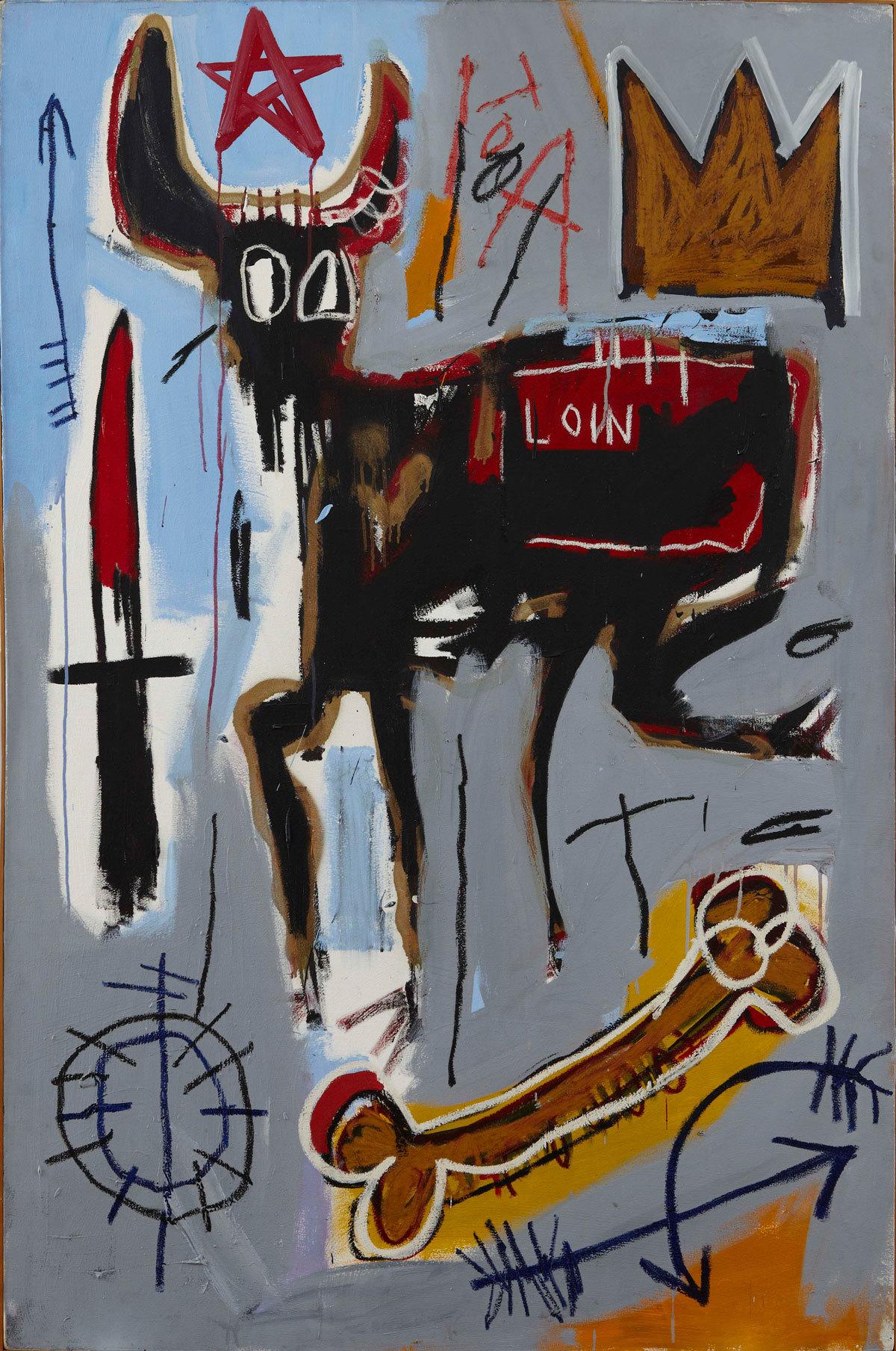
Jean-Michel Basquiat Loin, 1982 © Estate of Jean-Michel Basquiat. Licensed by Artestar, New York
When he died, aged just 27, of a heroin overdose, he left a legacy of over 1000 paintings and 3000 drawings. A life's work compiled in just 12 years. He'd gone from the streets to the elite of the art world, and most importantly, took the streets with him.
Basquiat's place in the world has always existed uneasily between extremes. He was a downtown punk and an uptown b-boy; he easily slipped between high culture and low culture, between Madonna and Andy Warhol. He came from the counter-cultural immediacy and language of graffiti, but his work tackles the serious legacy of Cy Twombly, Pablo Picasso and Francis Bacon. He's invoked by Jay Z as a status symbol and by Killer Mike as a social campaigner. He listened to Ravel's Bolero whilst painting, relaxed to Charlie Parker and Miles Davis, and performed in an experimental punk band called Gray. In a minimalist age he created incredibly complex work yet was still seen as a savant; as art's primal, wild man. The immediacy of his image making defies the complex arrangements that go into them, their casual beauty a cipher for an incredibly detailed visual language that he created, and he made these complex and difficult things look easy. He was the First Black Art Star, took black expression into the New York's white gallery scene, and became a genuine celebrity.
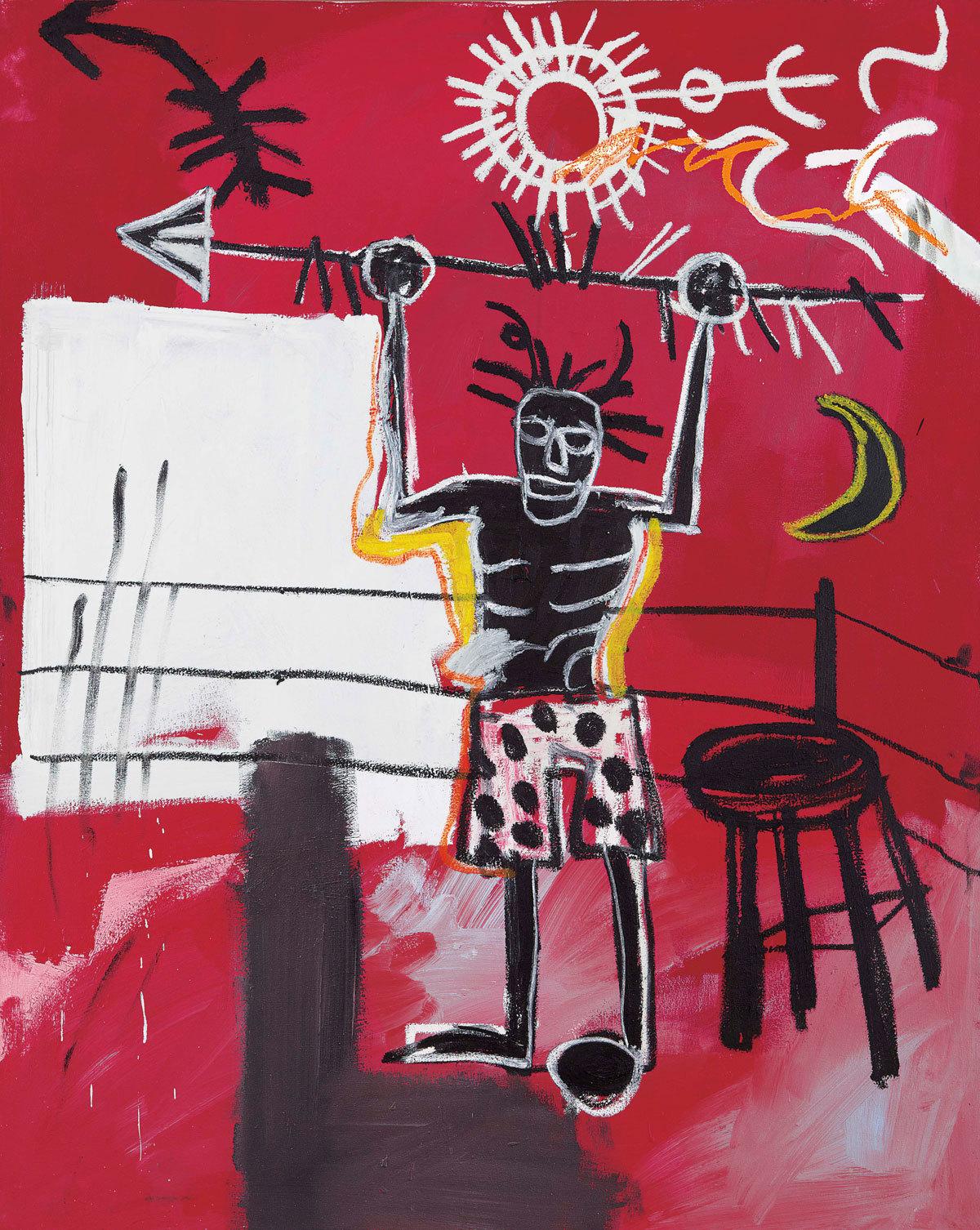
Jean Michel Basquiat The Ring, 1981. Private Collection, Courtesy Acquavella Galleries © Estate of Jean-Michel Basquiat. Licensed by Artestar, New York
"So what do we do," the poet Christian Campbell asks "with the cult mythologies about Basquiat, in which criticism on his art amounts to a TMZ report (Who did he fuck? How did he die? What was he on? How was his hair?)" The Guggenheim show's answer, refreshingly, is to ignore it and focus on the art.
The early paintings, made largely on reclaimed materials, pieces of boards, abandoned doors, bear the influences of Basquiat's time on the streets as a graffiti artist, his childhood dream of being a cartoonist, and his obsession with art history.
He also found black heroes missing in art, so figured them into his own work, and so turned modern black life into art. He saw the nobility and tradition of black life and culture as absent and venerated it. Early paintings like Famous Negro Athletes, that feature a scratched back face, a baseball, his signature crown; or King of Baseball, a blue figure, crown, and baseball. These are simple and forceful images, using single lines and few colours, and that minimalism reinforces their political point.
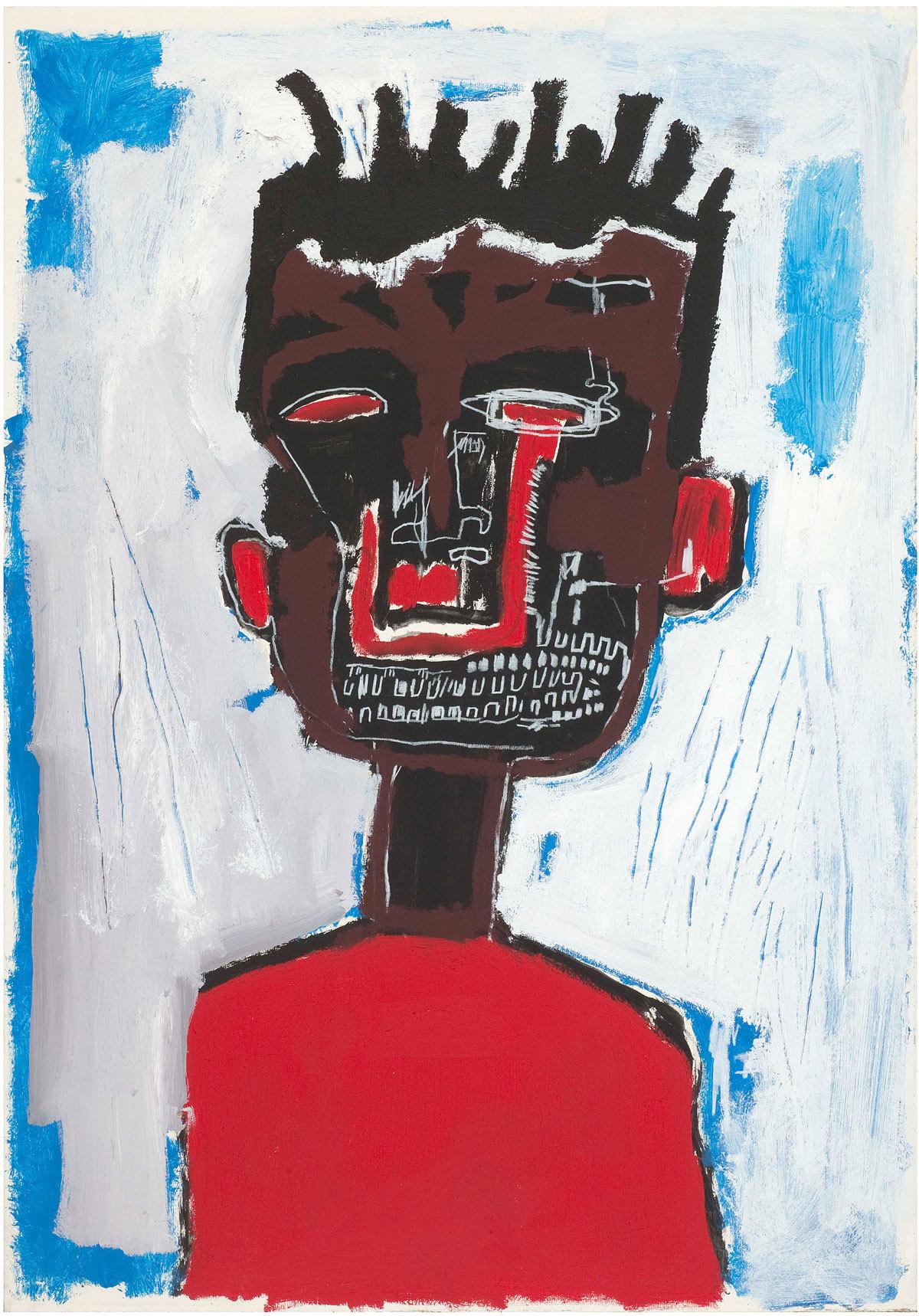
Jean Michel Basquiat Self-Portrait, 1984. Yoav Harlap Collection © Estate of Jean-Michel Basquiat. Licensed by Artestar, New York
Soon though, his paintings were becoming incredibly complex as he developed his unique visual language. His recurring motifs of black heads, crowns, copyright symbols, baseball players, boxers, text, text scratched out, bodies and the fascination with disembodiment; these motifs spread across his entire work, they crop up again and again, forming a visual link between his works.
In sportspeople, the boxers and baseball players, he saw African American heroes, he saw struggle, resistance, victory and strength. He often talked of having a boxing match with Julian Schnabel. His exhibition of collaborative paintings with Andy Warhol featuring a poster of both of them wearing boxing gloves. It was art as competition, and Basquiat sought to prove himself, as a black man in a white world.
Seeing so many of Basquiat's painting in once place, it becomes clearer and clearer that Basquiat's work's major theme is an unending questioning of America's racial politics and social hypocrisies. A critique of a world where he could sell work to collectors for incredible amounts of money and yet not be able to get a taxi home; where his friend and fellow graffiti writer, Michael Stewart, could be arrested and beaten to death by police; by his place as a lauded black artist showing his paintings on white walls, to white people, and by the way people belittled him, saw him as a novelty and treated him as primitive.
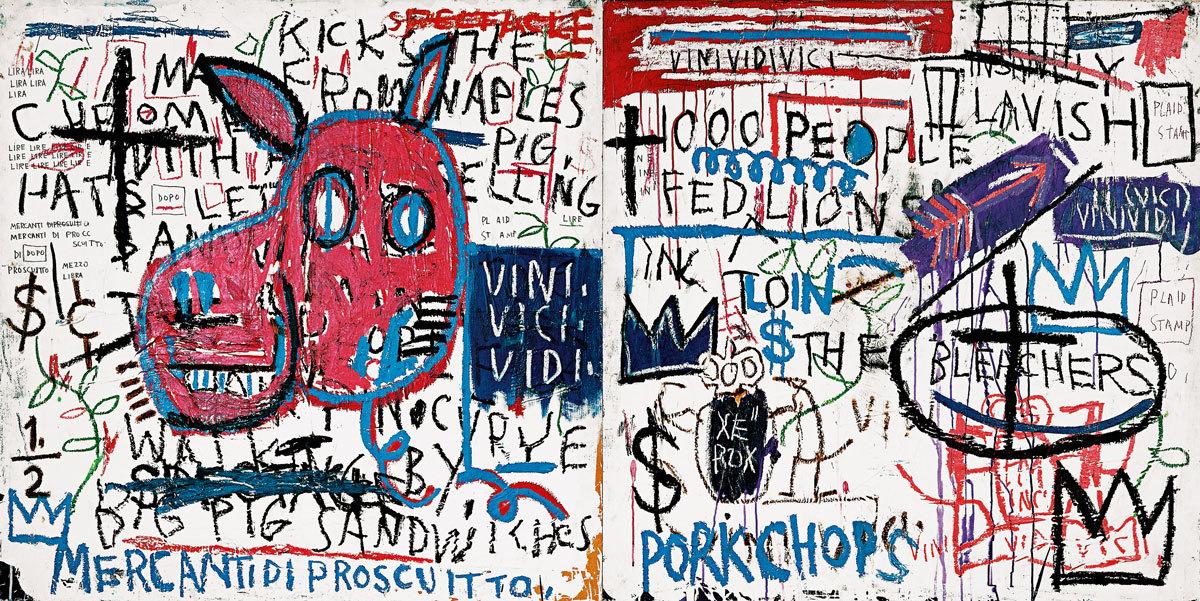
Jean-Michel Basquiat Man from Naples, 1982. Guggenheim Bilbao Museoa © Estate of Jean-Michel Basquiat. Licensed by Artestar, New York
His painting, Defacement, was a memorial to the his friend Michael Stewart, features two cartoonish, brightly coloured police officers, armed with batons, beating a black silhouette, under the word defacement. Who's being vandalised, who's defaced? The subway car that Michael Stewart was painting when the police attacked him? Or Michael himself. Basquiat paints Michael's body as a silhouette because it's not just a one off, not just Michael, it's any number of black men targeted by police, and it's not gone away.
Michael's death was a watershed moment for Basquiat and his political consciousness. The works up until that point had been content to simply place the black body within art's history, and reclaim it as a form of representation. After his death, they become more implicitly political, less cartoonish, and much angrier. Irony Of Negro Policeman, for example, is a grotesque caricature of the hypocrisy of oppressor joining the oppressed, his face a mask, his body caged in with lines of paint, daubed with the word 'pawn' in the corner.
When Basquiat started to work and become friends with Andy Warhol, in 83/84, he was himself seen as the pawn, Andy's pet, used to keep Andy relevant as his critical acclaim flagged. But Basquiat managed to draw Andy back to painting, in a series of collaborative works exhibited by Tony Shafrazi in 85, as well as a series derived from the The Last Supper, exhibited in Milan. The critics hated them, described Basquiat as an "art world mascot" and an "all too willing accessory"in the New York Times. They fell out, and after Andy's death, Basquiat became inconsolable, and turned to heroin in greater quantities.
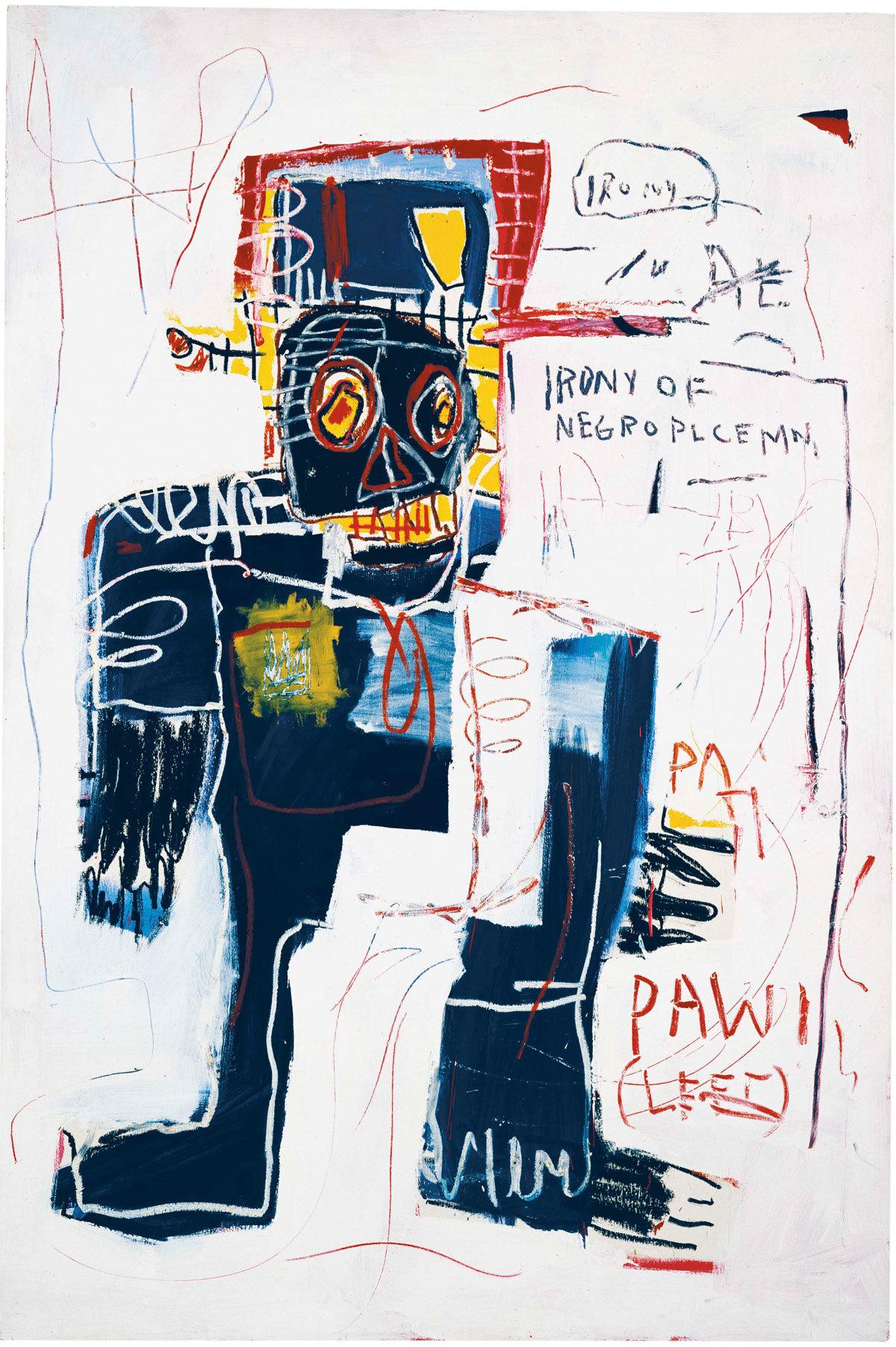
Jean Michel Basquiat. Irony of a Negro Policeman, 1981. Private Collection © Estate of Jean-Michel Basquiat. Licensed by Artestar, New York
His final works, exhibited for one night only at Baghoomian's gallery at the Cable Building in SoHo, New York, in 1988, just six months before death, show t=his grief, his work is stripped back, stripped of colour, pulsing with the intensity of language. He had become obsessed with listening to Beethoven's Eroica, and specifically, for differences between different versions and interpretations of the symphony. It could act as a metaphor for Basquiat's work as a whole, this revision, sampling, and language of symbols, that runs through his work.
The show is titled Now's The Time, a reference to Charlie Parker, but more obliquely, to Basquiat himself. Now's the time to revisit his work, to give him the museum retrospective his work deserves, but also because it's still the time to evaluate racism and stereotyping, by seeing it again through Basquiat's eyes, it's clear how little has changed in the last 27 years. How many Michael Stewart's have their been this year alone?

Jean-Michel Basquiat Eroica, 1987. Private Collection © Estate of Jean-Michel Basquiat. Licensed by Artestar, New York
But also, what Basquiat's career makes clear is how few black artists there've been since, how white the art world remains, and how patronising its attitudes can be. Basquiat might've painted black heroes into art, but he remains one of a few black heroes to make it and prove that black art matters.
